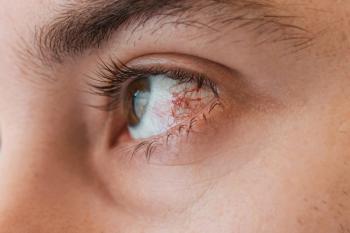
Eyenovia and SGN Nanopharma team up to develop a treatment for chronic DED
The companies announced that they will be working to develop SGN’s micellar nanoparticle platform to be used with Eyenovia’s Optejet dispenser in a news release.
Eyenovia and SGN Nanopharma have announced a collaboration agreement with the end goal to develop a treatment for chronic
“Our MNP cyclosporine was shown to be statistically superior in a head-to-head clinical study versus the current standard of care. The data demonstrates the efficacy of MNP Cyclosporine in as little as four weeks and a lower incidence of side effects such as corneal irritation,” said Navdeep Jaikaria, PhD, BSc (Hons), chairman and CEO of SGN Nanopharma, in the release. “With the precision dosing afforded by the Optejet dispenser, we believe we can further improve this promising drug's efficacy and tolerability profile. Our ‘drug-device’ combination therapy with Eyenovia has the potential to be the ‘best-in-class’ and to significantly improve patient outcomes and market penetration in this highly underserved dry eye market. We look forward to working with our partners at Eyenovia, and our investors toward this goal.”
Eyenova and SGN are currently validating the novel drug-device combination manufacturability to support clinical testing. An FDA consultation meeting will then be scheduled to discuss the clinical development of the product.1
A number of different APIs can be used with SGN’s MNP technology, including amorphous, crystalline, charged, and poorly water soluble ingredients. The technology can also coformulate multiple APIs with different physicochemical property in order to create stable and scalable formulations. Additionally, one API can be released faster than another when releasing several through the technology, allowing for more than 3 phases of administration. A slower release, for example, can be applied to an API in the oil phase in order to delay its availability to interact with the tissue. Stability has been demonstrated in more than 25 different APIs as stand alone or combination formulations.2
As for Eyenovia’s Otejet technology, dispensing topical eye medications remains consistent at the push of a button. The dispenser administers an 8μL dose of medication to the cornea in order to prevent drug overflow and possible overdosing.3
“Notwithstanding the widespread use of cyclosporine-based treatments for dry eye disease, currently available formulations have significant shortcomings, including a delayed onset of action of up to 12 weeks and unpleasant side effects that result in significant patient attrition and non-compliance,” said Michael Rowe, Eyenovia CEO, in the release. “The Optejet dispenser has been shown in prior studies to deliver a therapeutic dose of medication with 80% less drug volume, thereby minimizing exposure to harmful preservatives and improving tolerability. We believe the power of SGN’s MNP platform, when combined with the Optejet, will result in a more efficacious and better tolerated cyclosporine-based treatment that we believe has the potential to become the standard of care in this multi-billion-dollar addressable market.”
References:
Eyenovia and SGN Nanopharma announce collaboration agreement to develop novel treatment for chronic dry eye disease. News release. Eyenovia. July 30, 2024. Accessed July 30, 2024.
https://ir.eyenovia.com/news-releases/news-release-details/eyenovia-sgn-nanopharma-announce-collaboration-agreement-develop Our MNP nano-tech platform. SGN Nanopharma. Accessed July 30, 2024.
https://sgnnanopharma.com/technology/ Optejet technology. Eyenovia. Accessed July 30, 2024.
https://eyenovia.com/optejet-technology/#top
Newsletter
Want more insights like this? Subscribe to Optometry Times and get clinical pearls and practice tips delivered straight to your inbox.



















































.png)


